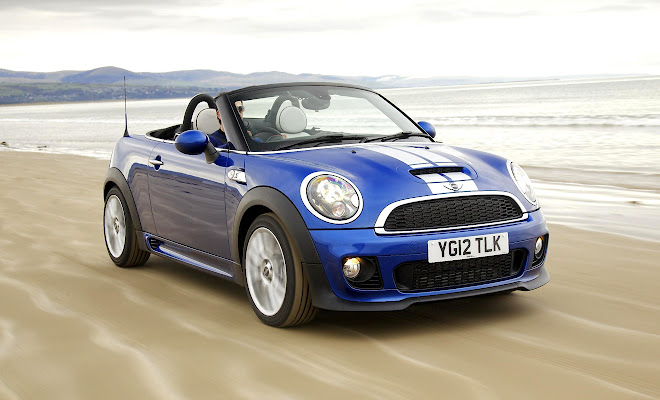by Lem Bingley 
With spring in the air, thoughts turn to the delights of open-top motoring. A leafy B-road, two seats and unlimited headroom seem like a much better idea than at any other time of year.
Most ragtop sports cars throw caution to the wind along with your hairstyle when it comes to fuel efficiency, but there are ways to keep a lid on consumption while peeling the lid off your car.
This article lists three different soft-top cars that share a few interesting traits. Each one is a strict two-seater with an opening roof. All three are surprisingly fuel efficient, given their fun-comes-first format. And all three were produced for a distressingly short space of time, and so sold in very limited numbers. Each has bags of character, will be fun to drive and ought to be reasonably reliable. In short, each one has future classic stamped all over it.
Each car also happens to be called Roadster...
Smart Roadster

Still going: about 5,000
Aim to spend: from £1,500 – but more for a good one
Luggage space is at a premium because the boot is full of engine. The rear-mounted 698cc petrol motor has just three wee cylinders but is turbocharged to yield 60, 80 or 100bhp – the highest power output can be found in the sportier Brabus editions.
The power might seem modest but so is the car, and with weight below 800kg there is a very healthy balance between poke and pork. The Roadster has attracted plenty of praise for its eager handling, and for serving up big dollops of fun even at responsible speeds.

The six-speed semi-automatic gearbox attracts more mixed reviews, criticized for slow-witted shifts, especially in the earliest cars. Column-mounted paddles were an option and are reportedly well worth seeking out.
Modern features like handsfree Bluetooth, iPod compatibility and satellite navigation were also on the Roadster options list but were pricey when new and likely to be missing from the factory fitted roster of most used examples. Any lack in this area is relatively easily fixed these days – simply grab a suitable offer from MyVoucherCodes and head to Halfords.
Fuel consumption can near the 50mpg mark, and insurance costs should be sensible. The official CO2 score falls between 116g/km and 122g/km, depending on engine power and tyre sizes.
Likely problems can be summed up in one word: leaks. The retractable fabric roof and its removable siderails don’t always seal too snugly, letting in rain. The door mirror housings are also prone to acting like tea-strainers, and expensive problems occur if water seeps into a box of vital electronics under the bonnet. Seals need to be kept in good shape with silicone lubricant, so steer well clear of any car that resembles a damp sponge.
Mini Roadster

Still around: about 6,000
Aim to spend: from £9,000
Closely based on the second-generation Mini Convertible, the Roadster ditched the rear pair of seats and gained a colossal (for a Mini) boot instead, topped off with a speed-activated spoiler.
While clearly assembled using a lot of big bits from the Mini hatchback parts bin, the Roadster still manages to look the part. Its steeply raked speedster windscreen, chromed roll hoops and neat soft-top with glass rear screen give it a unique look of its own, even if the body sides do seem a bit tall and slabby.

You sit low in the car, and will be treated to the modern Mini experience – minimal body roll, hyperactive steering, lively throttle response and a ride that skips and hops from one bump to the next.
Four-cylinder diesel and petrol engines were offered when the Roadster was new, with manual or automatic gearboxes. The 1.6-litre, 184bhp Cooper S is probably the most in keeping with the Roadster’s character, though it’s also worth pondering the appeal of a 2.0-litre diesel Cooper SD.
The 143bhp SD edition will get to 62mph in 8.1 seconds, but you’ll enjoy economy in the region of 50mpg (the official combined cycle figure is 63mpg) and a CO2 rating of just 118g/km.
When new, the SD cost £845 more than the S, though the price gap is typically negligible in the used market where age and condition matter most.
Tesla Roadster

Still around: 47
Aim to spend: a lot
In place of an Elise’s mid-mounted engine the Tesla used 6,831 lithium-ion laptop batteries, collectively storing 56kWh of energy. Via suitable control electronics, this power was fed through to a 185kW (248bhp) electric motor.
This was a potent combination even by today’s measures, where a battery powered BMW i3 can hold less than half the energy and employs a much less beefy 125kW (168bhp) motor, yet still provides pretty brisk performance.
With all its batteries aboard the Tesla Roadster’s range between recharges was comfortably in excess of 200 miles, while it could also entertain by zipping to 62mph in less than four seconds. And all with no tailpipe emissions whatsoever.

The drawback, of course, was extreme cost. UK prices started at about £88,000 on the road in 2009. A quicker Roadster Sport, with an uprated 125kW (168bhp) motor came in at around £103,000 and a battery upgrade to 70kWh capacity, providing 35% extra range, was offered from 2014 for about £20,000.
Just over 50 Tesla Roadsters were registered in the UK, and not all are still on the road. That lack of availability, combined with those high initial prices, mean residual values today remain as unyielding as the car’s stiff aluminium chassis.
At the time of writing, just one is for sale in the UK – a very early 2009 model with an asking price of almost £59,000.
It’s a high threshold, but there is a reasonable likelihood that the Tesla Roadster will gain in value over the long term. That makes the car a very interesting bet for an EV enthusiast with deep pockets.



